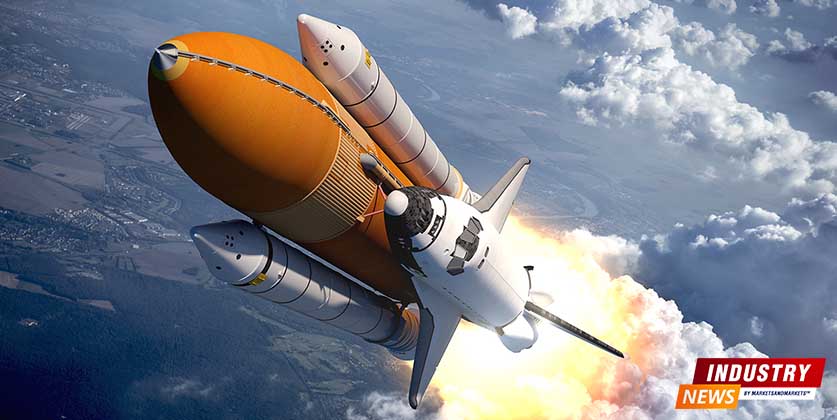Chandrayaan 3 – InDepth Look at Historically Important Milestone in Space Industry

This News Covers
- What is the Historic Importance of Chandrayaan 3?
- Which team worked on Chandrayaan 3?
- What was the cost of this mission?
- How many and which successful missions have been completed by ISRO?
- Who is the father of Indian space program?
The success of Chandrayaan-3 is not just a triumph for India but a testament to human ingenuity, collaboration, and the relentless pursuit of knowledge. It underscores the importance of space exploration and the potential benefits it can bring to humanity.
MarketsandMarkets welcomes this historically important achievement and feel immensely proud of it as an India based organization
Chandrayaan-3 is an ambitious lunar exploration mission by the Indian Space Research Organisation (ISRO).
It successfully landed on the unexplored south pole of the moon, making India the first country to achieve this remarkable feat, especially after Russia's Luna-25 failed in a similar mission.
This achievement comes after a failed attempt in 2019, where the Chandrayaan-2's lander crashed on the lunar surface. The successful landing of Chandrayaan-3 has been hailed as India's most significant scientific accomplishment. The rover, named "Pragyan", is equipped with instruments to conduct element and chemical composition experiments and a robotic path planning exercise for future exploration. It is expected to remain functional for two weeks, which is one lunar day, the duration its solar-powered equipment is designed to last.
The mission faced potential challenges, especially from lunar dust, which could impact the rover's moving parts. Lunar dust is different from Earth's and could stick to the rover's materials, potentially affecting its operation. It was accomplished with a budget of about 6.15 billion rupees (approximately $75 million). The lunar south pole is of particular interest because of its water ice, which could be a source of fuel, oxygen, and drinking water for future missions. However, the rough terrain of the south pole makes landing there challenging.
What is the Historic Importance of Chandrayaan 3?
Chandrayaan-3's successful landing has positioned India as a leading space power, enhancing its reputation for cost-competitive space engineering. The mission has boosted India's standing on the global stage and has been seen as a significant moment of national pride. The landing has also been recognized as an achievement for all of humanity, with Prime Minister Narendra Modi emphasizing its global significance.
India is now the fourth country, after the United States, the former Soviet Union, and China, to achieve a successful lunar landing. The Chandrayaan-3 mission has the potential to provide valuable scientific data about the moon's makeup, especially the south polar region, which is believed to harbor significant amounts of water ice. This information could be crucial for future crewed missions to the moon.
The success of Chandrayaan-3 could also pave the way for more significant achievements in India's space.
Which team worked on Chandrayaan 3?
Here's a detailed breakdown of the key individuals and their roles in the Chandrayaan-3 mission
Sreedhara Panicker Somanath, Chairman of the Indian Space Research Organisation (ISRO) since January 2022
Notable Achievements: Under his chairmanship, ISRO carried out the Chandrayaan-3 mission. The lander named Vikram and the rover named Pragyan successfully landed near the lunar south pole region on 23 August 2023. This made India the first country to successfully land a spacecraft near the lunar south pole and the fourth country to demonstrate a soft landing on the Moon.
Somanath has served as the director of the Vikram Sarabhai Space Centre and the Liquid Propulsion Systems Centre. He is known for his contributions to launch vehicle design, particularly in areas like structural design, dynamics, and pyrotechnics.
P. Veeramuthuvel, Project Director of the Chandrayaan-3 mission
Born in 1976 in the Villupuram district of Tamil Nadu, India. He graduated in aeronautical engineering from the Indian Institute of Technology, Kharagpur. He joined ISRO in 2014 and has worked on multiple projects, including the Mars Orbiter Mission (Mangalyan). In 2019, he was appointed as the director of the Chandrayaan-3 mission.
Kalpana K, Deputy Project Director of the Chandrayaan-3 mission
Full Name: Kalpana Kalahasti
Born in 1980 in Bengaluru, Karnataka, India. She graduated in aeronautical engineering from the Indian Institute of Technology, Kharagpur. She joined ISRO in 2003 and has been instrumental in the construction of various Indian satellites. She was involved in the Chandrayaan-2 and Mangalyaan missions. In 2019, she was appointed as the deputy project director of the Chandrayaan-3 mission.
These individuals, along with their teams and the broader ISRO community, played pivotal roles in the successful execution of the Chandrayaan-3 mission. Their expertise, dedication, and leadership have significantly contributed to India's advancements in space exploration
What was the cost of this mission?
The Chandrayaan-3 mission's estimated cost was around ₹615 crore, which is equivalent to approximately ₹721 crore or US$90 million in 2023.
Chandrayaan 3’s launch, orbit and descent
Here's a detailed breakdown of the launch, orbit, and descent of the Chandrayaan-3 mission:
- Date: Chandrayaan-3 was launched on 14 July 2023.
- Vehicle: The mission was launched aboard the LVM3 M4 rocket.
- Location: The launch took place from the Second Launch Pad at the Satish Dhawan Space Centre in Sriharikota, Andhra Pradesh, India.
- Initial Orbit: After the launch, Chandrayaan-3 entered an Earth parking orbit with a perigee (closest point to Earth) of 170 km and an apogee (farthest point from Earth) of 36,500 km.
Orbit:
- Trans-Lunar Injection: After a series of maneuvers that positioned Chandrayaan-3 in a trans-lunar injection orbit, the spacecraft was set on a course towards the Moon.
- Lunar Orbit Insertion: On 5 August 2023, ISRO performed a lunar-orbit insertion (LOI), successfully placing the Chandrayaan-3 spacecraft into an orbit around the Moon. This operation was carried out from the ISRO Telemetry, Tracking, and Command Network (ISTRAC) located in Bengaluru.
- Lander Separation: On 17 August, the Vikram lander separated from the propulsion module, marking the beginning of the final phase of the mission.
Descent:
- Date: The descent took place on 23 August 2023.
- Descent Process: As the Vikram lander approached the low point of its orbit, its four engines initiated a braking maneuver at an altitude of 30 km above the Moon's surface. After approximately 11.5 minutes, the lander was at an altitude of 7.2 km. It maintained this altitude briefly, then stabilized itself using eight smaller thrusters, transitioning from a horizontal to a vertical position while continuing its descent. The lander then used two of its four engines to slow its descent to about 150 meters. It hovered at this altitude for around 30 seconds to identify an optimal landing spot before continuing its descent and successfully landing on the lunar surface.
How many and which successful missions have been completed by ISRO?
The Indian Space Research Organisation (ISRO) has been at the forefront of space exploration since its establishment in 1969. Over the decades, ISRO has successfully launched a multitude of missions, ranging from satellite launches to interplanetary explorations. Here's a comprehensive overview of ISRO's successful missions, categorized by decades and types:
1970s:
- Aryabhata (1975): India's first satellite, launched by the Soviet Union.
- Rohini Satellite Series: Initiated in 1980, but the first successful launch using an Indian-made launch vehicle, SLV-3, was in 1980.
1980s:
- APPLE (1981): An experimental communication satellite, launched by the European Space Agency.
- Rohini Satellite RS-D1 (1983): Successfully placed in orbit by India's SLV-3.
- IRS-1A (1988): The first satellite in the Indian Remote Sensing series.
1990s:
- INSAT series: A series of multipurpose geostationary satellites commissioned in 1983 to cater to telecommunications, broadcasting, meteorology, and search and rescue operations. Several were launched in the 1990s.
- IRS-1B (1991), IRS-1C (1995), and IRS-1D (1997): Part of the Indian Remote Sensing satellite series.
- GSAT series: Geostationary communication satellites. The series began in the late 1990s and continues to the present day.
- PSLV (1993): The Polar Satellite Launch Vehicle's first successful flight took place in 1994.
2000s:
- Chandrayaan-1 (2008): India's first mission to the Moon, which helped confirm the presence of water/hydroxyl on the lunar surface.
- Cartosat series: High-resolution earth observation satellites. The series began in 2005 and continues to the present day.
- GSAT-3 (EDUSAT) (2004): India's first dedicated educational satellite.
- ASTROSAT (2015): India's first dedicated multi-wavelength space observatory.
2010s:
- Mars Orbiter Mission (Mangalyaan) (2013): Made India the first Asian nation to reach Martian orbit and the first nation globally to do so on its maiden attempt.
- GSAT-6A (2018): Communication satellite with a primary goal to provide mobile communication services through multi-beam coverage.
- Chandrayaan-2 (2019): Aimed to further scientific studies on the Moon. While the orbiter is successfully operating, the lander Vikram crash-landed.
Launch Vehicles:
- Satellite Launch Vehicle (SLV): India's first experimental satellite launch vehicle, capable of placing a small satellite in low Earth orbit. Operational between 1980-1983.
- Augmented Satellite Launch Vehicle (ASLV): Developed to enhance the payload capacity compared to the SLV. Operational between 1987-1994.
- Polar Satellite Launch Vehicle (PSLV): An expendable medium-lift launch vehicle designed to place satellites into geosynchronous transfer orbit and low Earth orbit. Introduced in 1993 and still operational.
- Geosynchronous Satellite Launch Vehicle (GSLV): Introduced in 2001 to enable India to launch its INSAT-type satellites. Still operational.
2020s:
- GSAT-30 (2020): A communication satellite to provide high-quality television, telecommunications, and broadcasting services.
- This list provides an overview of the major successful missions by ISRO. The organization has had numerous other successful satellite launches, technology demonstrations, and collaborative missions with other countries. ISRO's achievements have positioned India as a significant player in the global space community, known for its cost-effective and successful missions.
Who is the father of Indian space program?
The father of the Indian space program is Dr. Vikram Sarabhai. He is often referred to as the "Father of the Indian Space Program." Dr. Sarabhai was instrumental in establishing the Indian National Committee for Space Research (INCOSPAR) in 1962, which later evolved into the Indian Space Research Organisation (ISRO). Under his leadership and vision, India initiated its journey in space research and exploration. Dr. Vikram Sarabhai was a pioneering figure in the Indian space program and made significant contributions to various scientific and industrial fields. Here's a detailed overview of his life.
Personal Life:
- Born: 12 August 1919 in Ahmedabad, Bombay Presidency, British India (now in Gujarat, India).
- Died: 30 December 1971 in Trivandrum (now Thiruvananthapuram), Kerala.
- Family: He hailed from the renowned Sarabhai family, which was deeply involved in the Indian independence movement. His father was Ambalal Sarabhai.
- Marriage: Dr. Vikram Sarabhai married the classical dancer Mrinalini in 1942. They had two children: Mallika Sarabhai, who became a prominent actress and activist, and Kartikeya Sarabhai, who also pursued a career in science.
- Education: He initially attended Gujarat College in Ahmedabad. Later, he moved to the University of Cambridge, England, where he completed his tripos in natural sciences in 1940. In 1945, he returned to Cambridge to pursue his PhD, completing his thesis titled "Cosmic Ray Investigations in Tropical Latitudes" in 1947.
Professional career:
- Physical Research Laboratory (PRL): Known as the cradle of space sciences in India, PRL was founded by Dr. Vikram Sarabhai in 1947. It began its journey at his residence, "RETREAT", focusing on cosmic ray research. The institute was formally established at the M.G. Science Institute, Ahmedabad, in 1947.
- Indian Space Program: Dr. Sarabhai was instrumental in setting up the Indian National Committee for Space Research, which later became the Indian Space Research Organisation (ISRO). He initiated projects for the fabrication and launch of Indian satellites. As a result, the first Indian satellite, Aryabhata, was launched in 1975 from a Russian cosmodrome.
- Other Contributions: Sarabhai had diverse interests, ranging from science to sports and statistics. He established the Operations Research Group (ORG), India's first market research organization. He played a pivotal role in setting up institutions like the Nehru Foundation for Development, the Indian Institute of Management Ahmedabad (IIMA), the Ahmedabad Textile Industry's Research Association (ATIRA), and the Centre for Environmental Planning and Technology (CEPT). Alongside his wife, Mrinalini, he founded the Darpana Academy of Performing Arts. He also initiated projects like the Fast Breeder Test Reactor (FBTR) in Kalpakkam, Variable Energy Cyclotron Project in Calcutta, Electronics Corporation of India Limited (ECIL) in Hyderabad, and Uranium Corporation of India Limited (UCIL) in Jaduguda, Jharkhand.
Legacy:
- Physical Research Laboratory (PRL): Known as the cradle of space sciences in India, PRL was founded by Dr. Vikram Sarabhai in 1947. It began its journey at his residence, "RETREAT", focusing on cosmic ray research. The institute was formally established at the M.G. Science Institute, Ahmedabad, in 1947.
- Indian Space Program: Dr. Sarabhai was instrumental in setting up the Indian National Committee for Space Research, which later became the Indian Space Research Organisation (ISRO). He initiated projects for the fabrication and launch of Indian satellites. As a result, the first Indian satellite, Aryabhata, was launched in 1975 from a Russian cosmodrome.
- Other Contributions: Sarabhai had diverse interests, ranging from science to sports and statistics. He established the Operations Research Group (ORG), India's first market research organization. He played a pivotal role in setting up institutions like the Nehru Foundation for Development, the Indian Institute of Management Ahmedabad (IIMA), the Ahmedabad Textile Industry's Research Association (ATIRA), and the Centre for Environmental Planning and Technology (CEPT). Alongside his wife, Mrinalini, he founded the Darpana Academy of Performing Arts. He also initiated projects like the Fast Breeder Test Reactor (FBTR) in Kalpakkam, Variable Energy Cyclotron Project in Calcutta, Electronics Corporation of India Limited (ECIL) in Hyderabad, and Uranium Corporation of India Limited (UCIL) in Jaduguda, Jharkhand.
GET AHEAD
Top Research Reports to Fuel Your Industry Knowledge- Space Propulsion Market by Propulsion Type (Solid, Liquid, Electric, Solar, Hybrid), Component (Bipropellant Thruster, Hall-Effect Thruster, Rocket Motor), Platform (Satellite, Launch Vehicle), End User, Services and Region - Global forecast to 2030
- Space Launch Services Market by Service Type (Pre-launch, Post Launch), Payload (Satellite, Human Spacecraft, Cargo, and Space Probes), End User (Commercial, Military and Government), Orbit, Launch Vehicle, Launch type and Region - Global Forecast to 2027
- Space Militarization Market by Capability (Defense (Weapons, ISR, Electronic Warfare) Support (Navigation, Communications, Others), Solution (Space-based Equipment (Space Stations, Satellites), Ground-based Equipment, Logistics & Services)) and Region - Global Forecast to 2030
Editor's Pick

Healthcare
MiniMed™ 780G & Simplera Sync™: Smarter Tech, Simpler Lives for Diabetes Patients
Information and Communication Technology
Google Veo 2, Raising the Bar for AI Video Generation.jpg)
Automotive & Transportation
Trump’s Reciprocal Tariffs Stir Ripples Across the Automotive IndustryPODCASTS

Sustainable Digital Transformation & Industry 4.0
Sanjay Kaul, President-Asia Pacific & Japan, Cisco, and host Aashish Mehra, Chief Research Officer, MarketsandMarkets, in conversation on unraveling 'Sustainable Digital Transformation and Industry 4.0'
11 July 2023|S2E12|Listen Now

Generative AI
Prasad Joshi, Senior Vice President-Emerging Technology Solutions, Infosys, and host, Vinod Chikkareddy, CCO, MarketsandMarkets, in exploring the recent advances in AI and the generative AI space.
7 Nov 2023|S2E13|Listen Now
Space Propulsion Market
Download Whitepaper
Historic South Pole Landing on Moon
This made India the first country to successfully land a spacecraft near the lunar south pole and the fourth country to demonstrate a soft landing on the Moon.
Spacepower
Chandrayaan-3's successful landing has positioned India as a leading space power, enhancing its reputation for cost-competitive space engineering.












